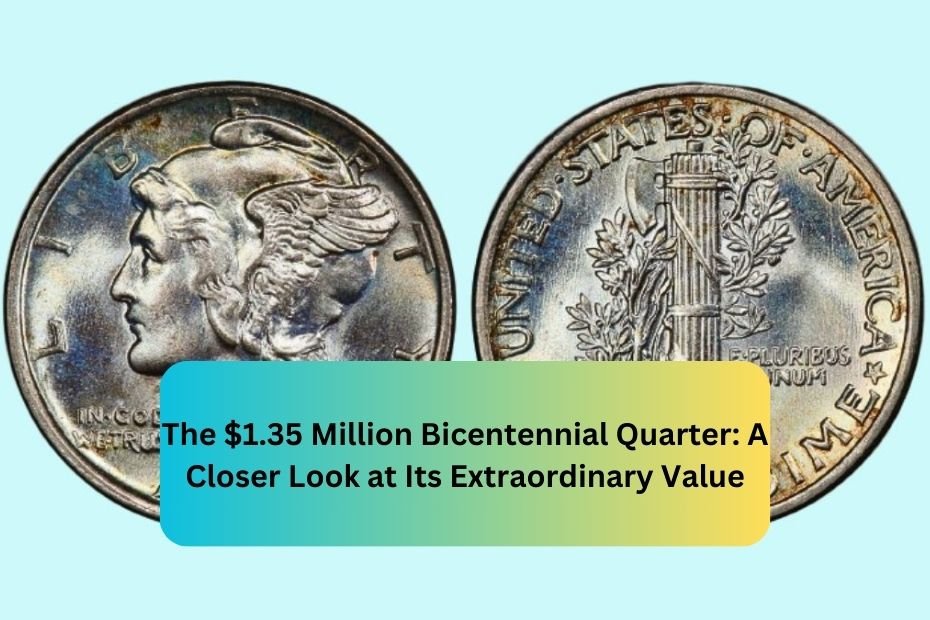The U.S. Mint issued the Bicentennial Quarter to commemorate America’s 200th anniversary of independence in 1976. While millions of these coins were minted, one specific coin in this series shocked the numismatic world when it fetched an astounding $1.35 million at auction. This coin’s extraordinary value derives from its rarity, unique qualities, and collector demand. This article will take a closer look at the factors that contributed to this Bicentennial Quarter’s sky-high valuation and help you understand what makes a coin so valuable.
What Is the Bicentennial Quarter?
The Bicentennial Quarter was issued as part of a set of commemorative coins celebrating the 200th anniversary of American independence in 1976. Unlike typical quarters that bear the year of minting, the Bicentennial Quarter features the dual dates “1776-1976.”
Key Features of the Bicentennial Quarter:
- Obverse (Front): Features a portrait of George Washington, similar to regular quarters.
- Reverse (Back): Depicts a Colonial drummer, a victory torch encircled by 13 stars, and the words “United States of America,” “E Pluribus Unum,” and “Quarter Dollar.”
- Mint Marks: The Bicentennial Quarters were minted at Philadelphia (no mint mark), Denver (“D”), and San Francisco (“S”).
Millions of these coins were produced, and while most are worth only face value, one exceptional piece made history due to its uniqueness.
The Extraordinary $1.35 Million Bicentennial Quarter
The $1.35 million Bicentennial Quarter is not your ordinary coin. It became famous not only because of its historical significance but due to its rare minting error and pristine condition.
Key Factors Contributing to the $1.35 Million Value:
a. Minting Error
One of the most significant factors that contributed to the astronomical value of this particular coin is a minting error. Error coins are produced by accident and usually exhibit some form of imperfection, such as a doubling of the design, missing features, or off-center strikes. In this case, the Bicentennial Quarter had a striking error that made it unlike any other.
Error coins are highly sought after by collectors due to their rarity, as they are not typically circulated in large numbers. The rarity of the $1.35 million Bicentennial Quarter’s error greatly contributed to its elevated value.
b. Silver-Clad Composition
Most Bicentennial Quarters were made with a copper-nickel composition. However, some were minted in a special silver-clad composition, consisting of 40% silver. These silver-clad coins were primarily issued in proof sets for collectors and are rarer than the standard copper-nickel quarters. The $1.35 million Bicentennial Quarter was made from this silver-clad composition, further adding to its rarity and desirability.
c. Perfect Condition
Coin collectors place tremendous value on the condition of a coin. The $1.35 million Bicentennial Quarter was graded as an MS-67, one of the highest possible grades. Coins are graded on a scale from 1 to 70, with 70 being a flawless coin. Very few Bicentennial Quarters, especially silver-clad ones, have achieved such high grades. The nearly flawless condition of the coin was a key reason it commanded such a high price.
d. Provenance
The history or origin of a coin, known as its provenance, can play a significant role in its value. Coins with a traceable history or that have belonged to famous collections often sell for higher prices. The $1.35 million Bicentennial Quarter came from a prominent collection, which increased its appeal and ultimate value.
e. Rarity and Demand
Even though millions of Bicentennial Quarters were minted, only a small fraction of them exhibit the rare characteristics of the $1.35 million coin. Combine that rarity with the high demand for error coins, and it’s easy to see why this coin fetched such a staggering amount at auction.
How Coin Values Are Determined
The value of a coin is determined by several factors, all of which played a role in the $1.35 million sale of the Bicentennial Quarter. Here are the primary elements that influence coin values:
a. Rarity
The rarer the coin, the higher its value. Coins that are scarce in quantity are highly desirable among collectors, and their limited availability drives up demand.
b. Condition
Condition, or the coin’s state of preservation, is another key factor in determining value. Coins are graded based on their condition, with a higher grade indicating better condition and a higher value. The $1.35 million Bicentennial Quarter was in MS-67 condition, making it one of the finest examples known to exist.
c. Market Demand
The demand for a specific type of coin can fluctuate based on collector trends. Coins tied to significant historical events or those with errors often generate high interest and demand.
d. Historical Significance
Coins tied to significant historical events or that feature iconic designs can be worth more. The Bicentennial Quarter holds importance due to its connection to the U.S. Bicentennial celebrations, adding to its value.
Other Notable Bicentennial Quarters
While the $1.35 million Bicentennial Quarter stands out, there are other rare Bicentennial Quarters that collectors should keep an eye on.
Notable Bicentennial Quarters and Their Features
| Coin Type | Rarity Level | Key Features | Approximate Value |
|---|---|---|---|
| Silver-Clad Proof Quarters | High | 40% silver, “S” mintmark | $8 – $20 |
| Double Die Obverse Errors | Rare | Doubling of inscriptions on obverse | $150 – $500 |
| Off-Center Strike Quarters | Very Rare | Off-center strike on the coin’s face | $250 – $2,000+ |
| Perfect MS-67 Condition | Extremely Rare | Immaculate, no visible flaws | $500 – $10,000+ |
Steps to Identify a Valuable Bicentennial Quarter in Your Collection
If you suspect you may have a valuable Bicentennial Quarter in your collection, follow these steps to identify its worth:
a. Check the Mintmark
The first step is to check the mintmark on the coin. Bicentennial Quarters were minted in Philadelphia (no mintmark), Denver (“D”), and San Francisco (“S”). The “S” mintmark indicates a silver-clad proof coin, which is more valuable than standard circulation coins.
b. Inspect for Errors
Look closely for any minting errors, such as doubled die features, off-center strikes, or missing elements. Use a magnifying glass or jeweler’s loupe to get a clear view of the details.
c. Assess the Condition
Examine the condition of your coin. Coins that show little to no wear, known as uncirculated coins, are far more valuable than heavily circulated coins. If your coin appears to be in pristine condition, it may be worth getting it professionally graded.
d. Research Coin Prices
Consult coin price guides or auction results to determine the potential value of your coin. Websites like PCGS and NGC provide up-to-date pricing information for various coin grades.
e. Consider Professional Grading
If you believe your coin is valuable, consider submitting it to a professional grading service like PCGS or NGC. Graded coins are assigned a value based on their condition, and a high-grade coin can sell for significantly more.
Steps to Identify a Valuable Bicentennial Quarter
| Step | Description |
|---|---|
| Check the Mintmark | Look for “S” mintmark for silver-clad coins or errors on other coins. |
| Inspect for Errors | Search for doubling or off-center strikes using a magnifying glass. |
| Assess the Condition | Examine for wear; uncirculated coins hold more value. |
| Research Coin Prices | Compare prices on coin websites and auctions. |
| Professional Grading | Submit rare coins for professional grading if they appear valuable. |
Conclusion
The $1.35 million Bicentennial Quarter is an extraordinary example of how rare coins can command incredible prices at auction. Factors such as a minting error, silver-clad composition, perfect condition, and provenance all played a role in elevating this coin to legendary status.
Whether you’re a seasoned coin collector or a beginner, identifying a rare Bicentennial Quarter in your collection can be a thrilling and potentially profitable pursuit. By following the steps outlined in this guide and paying attention to key details like mintmarks, condition, and errors, you could uncover a valuable treasure in your collection.
Why did the Bicentennial Quarter sell for $1.35 million?
The coin’s value was driven by a rare minting error, its silver-clad composition, nearly flawless condition (MS-67), and high collector demand.
How do I know if I have a valuable Bicentennial Quarter?
Check for a silver-clad composition (“S” mintmark), inspect for minting errors, and evaluate the coin’s condition. Coins with errors and in high-grade condition are often more valuable.
Where can I get my coin professionally graded?
Reputable services like PCGS (Professional Coin Grading Service) and NGC (Numismatic Guaranty Corporation) can grade your coin and help determine its value.
Are all silver-clad Bicentennial Quarters valuable?
While silver-clad Bicentennial Quarters are more valuable than regular ones, their value increases significantly with rare features, such as errors or exceptional condition.
What are the most common Bicentennial Quarter errors?
Common errors include double die obverse, off-center strikes, and missing elements, all of which increase the coin’s value.

